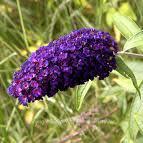Oregon Invasive Weed Awareness Week 2010

Black Knight – a rich, dark purple Buddleia with a delicious, plummy fragrance – was always my favorite butterfly bush. I pulled mine out about 15 years ago when I first heard about its invasive qualities. This spring, it was finally put on the quarantine list.
This week is Oregon Invasive Weed Awareness Week. What – that doesn’t sound like fun?
The intent of this wild publicity stunt (not really) is to increase public knowledge concerning invasive plant species throughout the state and help people learn how to address the problem of invasive species on their own property and in public spaces.
It may sound peripheral but it’s a huge problem with far-reaching economic and environmental consequences.
There are squidzillions of weedy plant species that are causing trouble for Oregon’s farms, ranches, nurseries, property owners and gardeners. They include plants brought in for ornamental, culinary, and medicinal purposes – even just hitchhikers on people’s shoes or boats – but all share one result: they spread rapidly and out-compete vital forage, farm and nursery crops, and native plants in their natural habitats.
Many of these plants are not ornamentals – they are weeds, pure and simple. Garlic mustard was originally introduced as food; nobody is trying to sell this scruffy little biennial herb anymore. But there are plenty of plants that pose a risk to native flora that have been sold in retail nurseries right up til recently.
On February 4 of this year, the Oregon noxious weed quarantine (OAR 603-52-1200) was amended to regulate three popular ornamental plants: butterfly bush, English ivy, and Scotch broom. A complete copy of the amended quarantine can be found here. Many people are not aware of the new rules – so here’s the scoop on these three newly-regulated invasive plant species:
Butterfly bush (Buddleia davidii and cultivars) is no longer permitted (except to sell back-stock to out-of-state buyers) – meantime, OSU and others are working on seedless cultivars; English ivy (Hedera helix) and the closely related and similarly invasive H. hibernica are prohibited from propagation, transport, purchase, or sale – including for indoor/patio, floral arrangements and topiary uses. Businesses may sell what they have on hand but may not buy new stock. The prohibition will be enforced starting June 1, 2010. And finally, Scotch broom (Cytisus scoparius), all varieties and cultivars, is prohibited.
Homeowners are not legally required to pull it out of their gardens. But if I still had it, I sure would.
To learn more about weeds, click here, on the Oregon Noxious Weed Control Program at the Oregon Department of Agriculture. Here’s Oregon’s Noxious Weed List. And here are profiles of all the weeds, with images and maps. If you’d like to go on a hike through the Nature Conservancy or another organization and help pull weeds while learning, check out this calendar of events is available, as well as Frequently Asked Questions about weeds.
